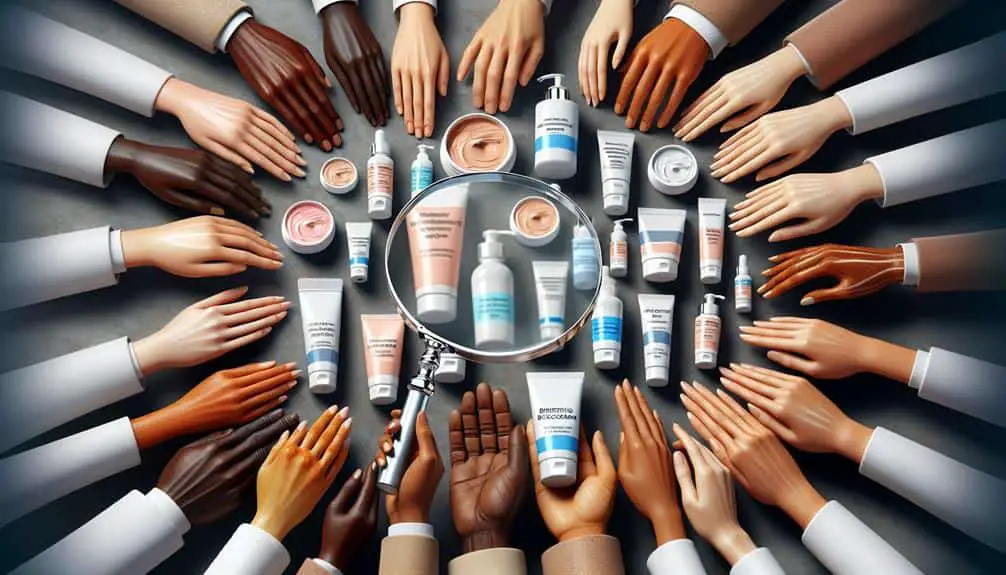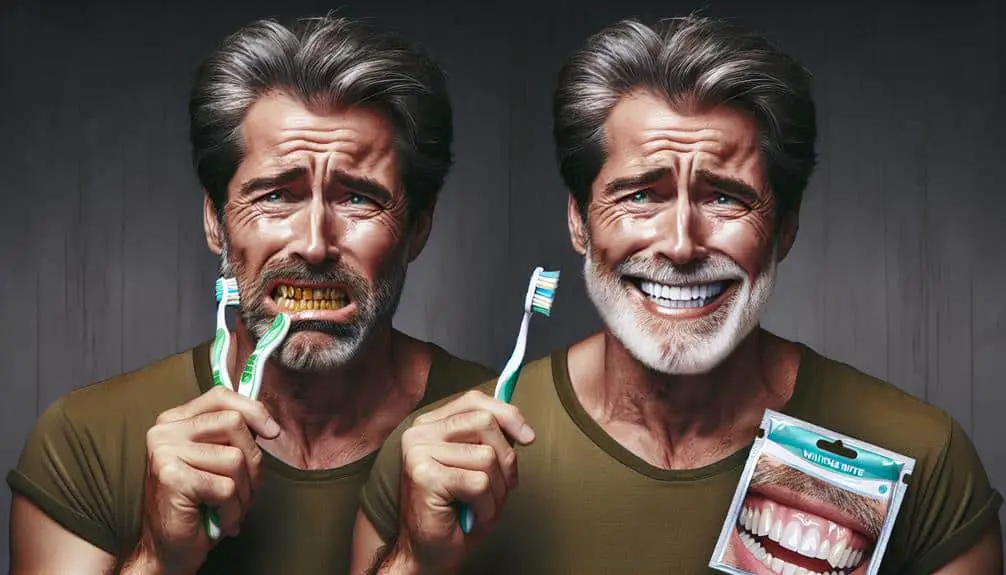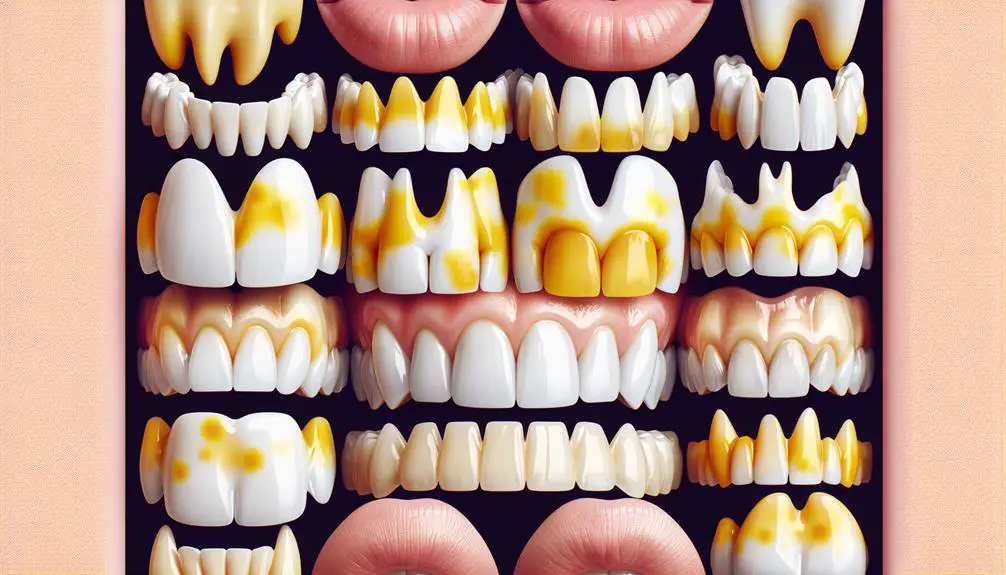If you're dealing with medication-induced discoloration, start by consulting your healthcare provider for guidance. Follow your medication regimen precisely to minimize risks. Avoid substances that may interact with your medication, like specific foods or cosmetics. Staying hydrated and maintaining good health can also help. Common culprits for stains include antibiotics, antipsychotics, and antimalarial drugs. Professional whitening treatments or at-home remedies like baking soda paste can help. To maintain a bright smile, prioritize oral hygiene, regular dental check-ups, and use fluoride toothpaste. These tips can aid in restoring your smile's radiance.
Key Points
- Consult healthcare provider for guidance on medication-induced discoloration.
- Practice good oral hygiene to minimize staining effects of medications.
- Consider professional whitening treatments for stubborn stains.
- Try natural remedies like baking soda or oil pulling for discoloration.
- Maintain oral health with regular check-ups and fluoride toothpaste.
Understanding Medication-Induced Discoloration
If you're experiencing changes in the color of your skin, nails, or mucous membranes due to medication, understanding medication-induced discoloration is essential for effective management.
Medication-induced discoloration can result from various causes, such as the medication's chemical composition, interactions with other substances, or metabolic processes in the body. It's vital to consult with your healthcare provider to determine the specific cause of the discoloration in order to implement appropriate prevention strategies.
Prevention of medication-induced discoloration involves several key steps. To start with, ensuring that medications are taken as prescribed and avoiding interactions with substances like certain foods, beverages, or cosmetics can help minimize the risk of discoloration. Additionally, staying hydrated and maintaining good overall health can support your body's ability to metabolize medications effectively, reducing the chances of developing skin or nail discoloration.
Identifying Common Medication Stains
Identifying common medication stains is important for recognizing potential discoloration issues caused by specific medications. Stain prevention starts with understanding the medications that are more likely to cause discoloration. Some common culprits include certain antibiotics like tetracycline, antipsychotic medications such as chlorpromazine, and antimalarial drugs like chloroquine. These medications can lead to different types of stains, ranging from yellow or brown to gray or blue-gray discolorations.
Being aware of these common medication stains can help you take proactive measures to prevent or minimize discoloration causes. If you're prescribed any of these medications, it's essential to discuss potential side effects, including tooth discoloration, with your healthcare provider. They may suggest alternative medications or dosage adjustments to lessen the risk of staining. Additionally, practicing good oral hygiene, including regular brushing and professional cleanings, can help reduce the impact of medication-induced discoloration on your teeth.
Professional Whitening Options for Stains
Explore professional whitening options as effective solutions for medication-induced discoloration on your teeth. Professional whitening treatments, offered by cosmetic dentistry experts, can greatly enhance the appearance of stained teeth caused by medication. These treatments involve the use of advanced whitening agents that penetrate the enamel to break down and remove deep-seated stains effectively.
One popular professional whitening option is in-office bleaching, where a high-concentration bleaching gel is applied to the teeth and activated by a special light. This method can produce rapid and noticeable results in just one visit to the dentist's office.
Another common professional whitening technique is take-home whitening kits prescribed by dentists. These kits include custom-made trays filled with a whitening solution that patients wear for a specified amount of time each day. While results may take longer to achieve compared to in-office treatments, take-home kits can be more convenient for some individuals.
Consulting with a dental professional is vital to determine the most suitable professional whitening option based on your specific needs and the extent of the discoloration caused by medication.
At-Home Remedies for Discoloration
Consider incorporating simple and effective at-home remedies to address discoloration of your teeth caused by medication. Here are some DIY treatments and natural solutions that can help brighten your smile:
- Baking Soda Paste: Create a paste using baking soda and a small amount of water. Gently brush this paste onto your teeth to help remove surface stains.
- Oil Pulling: Swish a tablespoon of coconut oil around in your mouth for 15-20 minutes. This traditional remedy is believed to help remove toxins and whiten teeth.
- Strawberries: Mash up a ripe strawberry and mix it with baking soda to create a natural whitening paste. The malic acid in strawberries can help lighten stains on your teeth.
- Apple Cider Vinegar Rinse: Dilute apple cider vinegar with water and swish it around in your mouth for a few minutes. Be cautious with this method as the acidity of vinegar can erode tooth enamel if used excessively.
These at-home remedies offer natural alternatives to address medication-induced discoloration, promoting a brighter and healthier smile.
Maintaining a Bright Smile Long-Term
To maintain a bright smile long-term, prioritize consistent oral hygiene practices and regular dental check-ups. Preventive measures are key in preserving the whiteness of your teeth. Brush your teeth at least twice a day using fluoride toothpaste to remove plaque and prevent staining. Floss daily to clean between teeth and along the gumline, where discoloration can easily occur. Consider incorporating a mouthwash into your routine to help kill bacteria and freshen breath, promoting overall oral health.
Long term strategies also involve watching your diet. Limit foods and beverages that are known to stain teeth, such as coffee, tea, red wine, and berries. If you do consume these items, rinse your mouth with water afterwards to minimize their effects. Regular dental check-ups are essential for maintaining a bright smile. Your dentist can provide professional cleanings and address any developing issues before they worsen. By following these preventive measures and long-term strategies, you can ensure your smile stays radiant for years to come.
Frequently Asked Questions
Can Certain Medications Cause Discoloration in Specific Areas of the Teeth or Gums?
Certain medications can indeed cause discoloration in specific areas of your teeth or gums due to their side effects. Maintaining good oral hygiene practices can help mitigate these effects and preserve the health of your smile.
Are There Any Natural Remedies That Can Help Prevent Medication-Induced Discoloration?
You can explore herbal remedies and prevention techniques to combat medication-induced discoloration. Incorporating lifestyle changes and natural solutions may help minimize the effects. Stay informed and consult professionals for the best course of action.
How Does Age Play a Role in the Severity of Medication-Induced Discoloration?
Age plays a significant role in the severity of medication-induced discoloration. Factors like skin elasticity and circulation can worsen with age, impacting how the body reacts to medications. Treatment options vary, from cosmetic solutions to genetic predispositions.
Can Medication-Induced Discoloration Be Reversed Completely With Professional Whitening Treatments?
Professional whitening treatments can greatly improve medication-induced discoloration, but complete reversal may not always be possible. Consider long-term effects and consult with a dentist for personalized advice on your situation.
Are There Any Specific Dietary Habits That Can Worsen Medication-Induced Discoloration?
To prevent worsening medication-induced discoloration, watch your dietary choices. Certain foods and drinks can stain teeth more. Maintain good oral hygiene and consider lifestyle changes like limiting coffee and red wine intake for preventive measures against discoloration.



